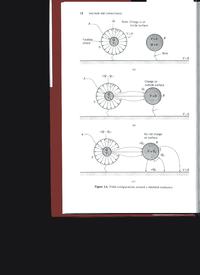jmvalks
Newbie level 5
I am reading Ralph Morrison's book Grounding and Shielding: Circuits and Interference, 5th ed. and in the section on electric field patterns he has a conductor, A, containing a charge (charge Q at potential V1) completely surrounded by a shield, so no electric field escapes. This screen is attached by a wire to a ground plane (VB = 0).
He then has two similar situations, with a small hole in the screen surrounding A that lets some of the charge from A terminate on a nearby conductor, B, connected to ground by a small wire, and on a conductor, C, floating (not connected to ground) at a potential V2. He goes on to say there is a charge distribution on both B and C, but that C has a zero net charge, as some field from C is terminating on the ground plane, and also that C is not at ground potential; whereas B has a net charge but is at ground potential.
My questions are:
Why is there a charge distribution at all, when I would expect the charge to be evenly distributed along the surface of conductors B and C?
Why should there be no net charge on C, i.e., why should there be sufficient negative charge on C causing an electric field to terminate on the ground plane sufficient to balance that caused by the field terminating on C from A?
I hope all this makes sense.
Thanks,
JMV
He then has two similar situations, with a small hole in the screen surrounding A that lets some of the charge from A terminate on a nearby conductor, B, connected to ground by a small wire, and on a conductor, C, floating (not connected to ground) at a potential V2. He goes on to say there is a charge distribution on both B and C, but that C has a zero net charge, as some field from C is terminating on the ground plane, and also that C is not at ground potential; whereas B has a net charge but is at ground potential.
My questions are:
Why is there a charge distribution at all, when I would expect the charge to be evenly distributed along the surface of conductors B and C?
Why should there be no net charge on C, i.e., why should there be sufficient negative charge on C causing an electric field to terminate on the ground plane sufficient to balance that caused by the field terminating on C from A?
I hope all this makes sense.
Thanks,
JMV
